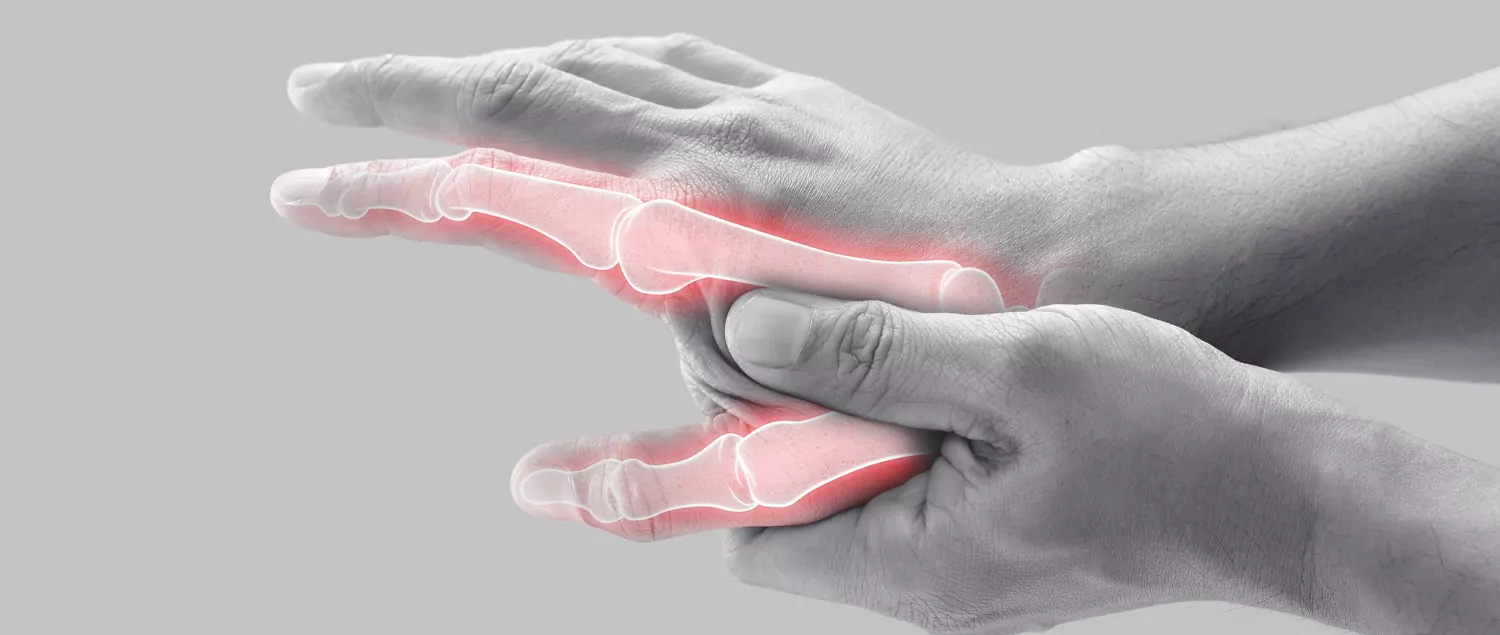What is Rheumatoid Arthritis (Inflammatory Rheumatism)?
Rheumatoid arthritis (inflammatory rheumatism) is an autoimmune, inflammatory health problem that can affect different tissues and organs of the body, especially the joints. Autoimmune diseases occur when the immune system recognizes one’s own tissues and organs as harmful pathogens and defends against them. The question “What is rheumatoid arthritis?”, also commonly referred to as inflammatory rheumatism, can be answered briefly as a chronic disease that develops as a result of a wrong reaction of the immune system. Inflammatory rheumatism, which often affects the small joints in the hands and feet, can also affect other tissues and organs of the body, including the skin, eyes, lungs and cardiovascular system.
Rheumatoid arthritis, which affects small joints in the early stages, usually progresses symmetrically, meaning it can affect similar joints on both sides of the body. Inflammatory rheumatism is a progressive disease that requires lifelong follow-up. Therefore, if it is not diagnosed and treated in the early period, it may cause joint damage, cartilage and bone erosion, and symptoms such as severe pain and limitation of movement may occur (1).
Symptoms of Rheumatoid Arthritis (Inflammatory Rheumatism)
Symptoms of rheumatoid arthritis may vary depending on the stage of the disease. Diseases that cause damage to the joints are generally defined as arthritis. Today, more than 100 types of arthritis are known. The main common feature is pain and swelling in the joints. However, the most important difference that distinguishes rheumatoid arthritis from others is that both sides of the body are affected by the disease (2, 3). For this reason, the first thing that comes to mind when it comes to rheumatoid symptoms is pain and inflammation in the joints on both sides of the body. In this case, for those who wonder “What is inflammatory rheumatism?”, it is possible to say that the disease takes its name from inflammation in the joints. These symptoms are usually more severe during periods of exacerbation of the disease. The main symptoms of inflammatory rheumatism are as follows (3, 4):
- Pain felt in more than one joint,
- Stiffness in the joints, especially after sitting for a long time or waking up in the morning,
- Tenderness and swelling in more than one joint,
- Pain and swelling in the same joints on both sides of the body,
- Weakness and fatigue,
- Mild fever.
Symptoms of inflammatory rheumatism of the legs are usually initially felt in the joints of the feet. However, if it is not intervened early, it can spread to the knee and hip joints and cause destruction in these joints. In addition, symptoms of inflammatory rheumatism may not always appear in the joints. Organs such as the kidneys, lungs and brain can also be affected. For this reason, symptoms of inflammatory rheumatism in the brain include depression and difficulty in thinking and problem solving, also known as brain fog, while rheumatoid arthritis in the heart can manifest itself with serious complications such as heart attack (5).
What Causes Rheumatoid Arthritis (Inflammatory Rheumatism)?
Rheumatoid arthritis is among the autoimmune diseases that develop due to improper stimulation of the immune system. Normally, the immune system is the system responsible for protecting the person from diseases and harmful pathogens. When faced with internal threats such as cancer cells or external threats such as viruses and bacteria that may pose a threat to the human body, the cells of the immune system are activated to defend against threats.
Any disruption to this normal functioning can lead to various health problems. Autoimmune diseases, which are diseases of the immune system, occur when the immune system perceives one’s own tissues and organs as harmful and defends against them with antibodies. Looking at the studies on “What causes rheumatoid arthritis?” it can be seen that rheumatoid arthritis is an autoimmune disease.
Although the exact cause of rheumatoid arthritis is unknown, several studies have shown that genetic and environmental factors play a role in the development of the disease. According to some research, mutations in subtypes of genes known as HLA genes, such as HLA-DRB1, which help the immune system determine which pathogens other cells of the immune system should respond to, can cause inflammatory rheumatism (1). Based on this, genetic predisposition is one of the main answers to the question “What causes inflammatory rheumatism?”.
In addition to genetic factors, other factors can increase the risk of rheumatoid arthritis. Accordingly, the main rheumatoid arthritis risk factors are as follows (6):
- Gender: Women may have a higher risk of developing inflammatory rheumatism than men. According to a study, the risk of women developing rheumatoid arthritis at some point in their lives is 3.6%, while this rate is 1.7% in men (1).
- Age: Although rheumatoid arthritis can occur at any age, the risk of the disease may increase with age. Some studies show that rheumatoid arthritis is more common especially in people aged 65-80 years (1).
- Smoking: A review of various studies on the causes of rheumatoid arthritis shows that smoking is one of the most important modifiable risk factors that increase the risk of the disease. This risk is especially higher in people with a family history of RA and smokers. In addition, tobacco and tobacco products, such as cigarettes, can also cause an increase in the severity of symptoms.
- Obesity Another known risk factor for rheumatoid arthritis is obesity. Research suggests that the risk of inflammatory rheumatism may increase by 30% in obesity patients with a body mass index (BMI) over 30 kg/m2 and by 15% in those with a BMI between 25 and 29.9 kg/m2 (1).
In addition to the above, rheumatoid arthritis is closely related to dietary habits. Some studies suggest that those who eat a diet high in calories and low in dietary fiber, also known as a Western-style diet, may have a higher risk of rheumatoid arthritis compared to those who frequently consume foods high in Omega-3

Rheumatoid Arthritis (Inflammatory Rheumatism) Treatment
Symptoms of rheumatoid arthritis vary from person to person. The most important reason for this is that the disease progresses differently in each patient. Therefore, the treatment of rheumatoid arthritis may vary depending on the stage of the disease and the severity of the symptoms. For the treatment of inflammatory rheumatism, experts first aim to determine the stage of the disease with imaging methods such as MRI (Magnetic Resonance Imaging) and ultrasonography. Rheumatoid arthritis is mainly analyzed in 4 stages. Accordingly, the main rheumatoid arthritis stages and treatment methods are as follows (7, 8):
- Rheumatoid arthritis 1. Stage: In this stage, also called the early stage of rheumatoid arthritis, patients may experience symptoms such as mild pain in the joints and stiffness in joints such as the fingers, especially in the morning. In this stage, there is inflammation inside the joints and in the synovium tissue lining the joints, but cartilage and bones are not damaged. Diagnosing the disease at this stage can be difficult. However, if the disease is diagnosed by making an appointment with a specialist doctor and the appropriate treatment process, such as medication, is started within 12 weeks, the disease may regress.
- Rheumatoid arthritis 2. Stage: The cartilaginous tissue as well as the lining of the joints begins to be affected by the disease. This can lead to severe pain and limitation of movement. At this stage of the disease, specialists may increase the dose or change the medication to control the patient’s symptoms. Rheumatoid arthritis medicines can help reduce inflammation in the joints and control symptoms.
- Rheumatoid arthritis 3. Phase 3. In stage patients, the wear on the cartilages is severe. There is also more bone destruction. As the cartilage wears away, the bones begin to rub against each other. This means more pain and loss of movement. In addition, bone destruction can cause deformities such as curvature and thickening of the fingers. During the treatment of this stage of rheumatoid arthritis, specialists may also include drugs known as biologics, which can help regulate the immune system’s working mechanism. In addition, surgical methods can be used to treat inflammatory rheumatism in cases of severe limitation of movement.
- End-stage rheumatoid arthritis: Not all cases of rheumatoid arthritis progress to end-stage. In this stage, there is no inflammation in the joints. However, pain, stiffness and swelling persist. Patients at this stage may become unable to move their hands, fingers and knees or have difficulty moving them. Specialists may resort to joint replacement surgery at this stage.
Treatment methods for advanced rheumatoid arthritis include surgical procedures. Rheumatoid arthritis surgery can be performed in different ways. The main surgical treatment options are as follows (9):
- Synovectomy where the inflamed synovium (joint lining) is removed,
- Joint replacement surgery in which the joint is completely removed and replaced with implants made of materials such as metal or plastic, i.e. prostheses,
- Joint fusion surgery, which aims to surgically fuse the joint when removal of the joint is not possible,
- Tendon repair surgery in case of damage to the tendons around the joints.
In addition to medication and surgical treatment, physical therapy can also be used in inflammatory arthritis.
What is Good for Rheumatoid Arthritis (Inflammatory Rheumatism)?
Since rheumatoid arthritis is a progressive and chronic disease, it is important that patients are followed by a specialist doctor throughout their lives. However, those who wonder “What is good for inflammatory rheumatism?” may be advised to exercise regularly. However, since RA patients are at high risk of developing damage to their joints and bones, it is recommended that the exercise program be prepared by a specialist doctor. In addition, resting during periods of exacerbation of the disease, i.e. when the severity of symptoms increases, may also help rheumatoid arthritis (3).
How should rheumatoid arthritis (inflammatory rheumatism) be nourished?
There is some research showing a direct relationship between rheumatoid arthritis and dietary habits. This is why it is important that patients with inflammatory rheumatism pay attention to a healthy and balanced diet. Experts say that for people with rheumatoid arthritis, eating foods that can help reduce inflammation in the joints and relieve pain can help control symptoms. The main foods recommended to be included in the rheumatoid arthritis nutrition list (10):
- Fish rich in healthy fats such as omega-3 fatty acids,
- Vegetables such as cauliflower, broccoli, rich in phytochemicals such as sulforaphane, which has anti-inflammatory properties,
- Turmeric, rich in a substance called curcumin, which can help relieve pain,
- Fermented foods such as yogurt, which can help reduce inflammation,
- Ginger known for its anti-inflammatory effects,
- Green tea, which contains ingredients that can help reduce inflammation,
- Fresh vegetables and fruits,
- Whole grains
Patients with rheumatoid arthritis may also benefit from avoiding foods with high sugar content such as white rice, bread and pasta, and processed products (10).
According to some studies, rheumatoid arthritis may have had a negative impact on life expectancy in the past, but today, with the right treatment plan, it is possible for patients to have the same life expectancy as healthy people. For this reason, it is important that people in the risk group, especially those with a family history of rheumatoid arthritis, make an appointment with a specialist doctor and have the necessary controls.





